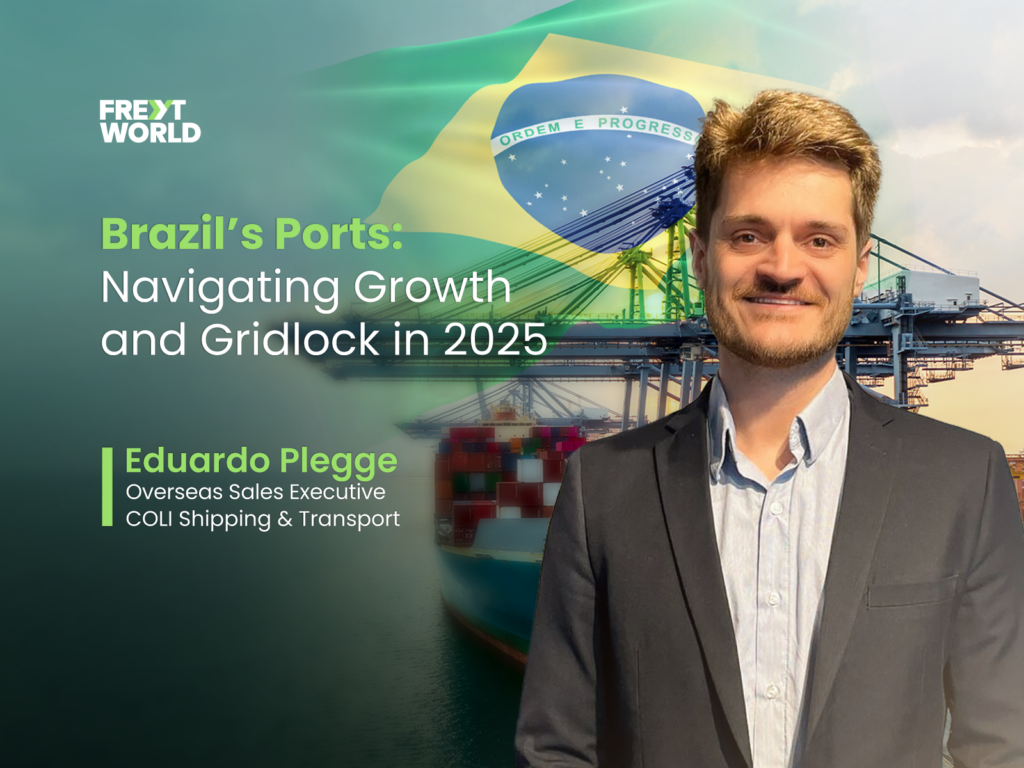By Eduardo Plegge, Overseas Sales Executive for COLI Shipping & Transport

Brazil’s ports are at a critical juncture. As the country’s trade volumes surge, driven largely by agribusiness exports, infrastructure bottlenecks and operational inefficiencies have reached a tipping point. The Port of Santos, Latin America’s busiest hub, exemplifies both the opportunities and challenges facing Brazil’s maritime sector. Let’s examine the latest developments, their implications for global supply chains, and what lies ahead.
The Capacity Crisis: A System Under Strain
In 2024, Brazil's ports handled 5,663 container shipments, but only 23% departed on schedule. Delays affected 55% of vessels at major ports like Santos, with some waiting up to 10 days to berth. For agribusiness, these delays are costly: in March 2025 alone, congestion prevented the export of 600,000 bags of coffee (1,932 containers), resulting in $1.57 million in losses. Since mid-2024, inefficiencies have added $11.72 million in extra costs for coffee exporters, funds that could otherwise enhance product value or expand operations.
The root cause is a mismatch between soaring demand and stagnant infrastructure. Container throughput has doubled since 2010, yet investment in ports remains inadequate. Brazil allocated just 2.2% of GDP to infrastructure in 2024—half the 4.3% needed to meet projected demand. At Santos, which handles 60% of Brazil’s containerized cargo, terminals operated at 100% capacity for most of 2024, exacerbating delays.
The Port of Santos: Expansion and Innovation
Santos is central to Brazil’s trade ambitions. In 2024, it shipped 179.8 million tons of goods, a figure expected to rise to 188 million tons in 2025. To accommodate growth, the Santos Port Authority (APS) has launched a R$12.6 billion ($2.5 billion) modernization plan, including:
Draft Deepening: The navigation channel will be deepened to 16 meters by 2026 and 17 meters by 2031, allowing larger vessels like 18,000-TEU ships to dock. This aligns with global trends toward mega-ships and strengthens Brazil’s position in trade with China, which accounts for 60% of Santos’ agricultural exports.
Digital Twin Technology: A virtual replica of the port, developed with Itaipu Parquetec, enables real-time monitoring of vessel traffic and cargo flow. The system simulates operational scenarios, such as new shipping routes, without disrupting current activities. Similar technologies in Rotterdam and Houston have reduced turnaround times by 15–20%, and Santos aims to match these gains.
Terminal Expansions: DP World’s terminal at Santos set a record in 2024, handling 1.25 million TEUs—a 14% annual increase. The company is investing $85 million in equipment and capacity upgrades, while Brasil Terminal Portuário (BTP) has resumed full operations after a berth closure in early 2024.
Despite these efforts, relief remains years away. Santos Brasil and DP World’s expansions won’t conclude until 2026, and organic cargo growth risks outpacing infrastructure improvements. “Terminals are racing to add capacity, but demand shows no signs of slowing,” notes Casemiro Tércio Carvalho of 4 Infra.
Regional Ports: Decentralizing Trade
To reduce reliance on Santos, Brazil’s government is incentivizing regional port development. The New Growth Acceleration Program (Novo PAC) has earmarked R$54.7 billion ($10.8 billion) for 37 new port leases by 2026, with a focus on the North and Northeast. Key projects include:
Port of Pecém: Now a hub for green hydrogen, Pecém saw record cargo volumes in 2024, driven by renewable energy investments.
Paranaguá and Rio Grande: These ports are critical for soybean and meat exports. Privatizing their navigation channels aims to attract private dredging contracts, ensuring deeper drafts for Panamax vessels.
However, decentralization faces hurdles. Portonave in Santa Catarina and Itajaí’s suspended operations in 2024 highlighted the fragility of regional networks. “Expanding capacity nationally is essential, but execution must be meticulous to avoid creating new bottlenecks,” says Anderson Pomini, APS President.
Regulatory Reforms and Trade Agreements
Brazil’s regulatory landscape is evolving to support growth. The Federal Government has privatized navigation channels at five major ports, streamlining dredging and berthing processes. Meanwhile, the Mercosur-European Union trade deal, pending ratification, could boost Brazilian exports by $7 billion annually.
Customs modernization is another priority. The New Import Process, set for full implementation in late 2025, promises to cut clearance times from nine days to five through electronic processing. However, recurring strikes by customs auditors—such as the June 2025 “zero clearance” protest at Santos—underscore systemic labor tensions that could delay reforms.
The Agribusiness Lifeline and Its Logistics Toll
Agribusiness accounted for 48.9% of Brazil’s $164.4 billion exports in 2024. Soybeans, corn, coffee, and sugar move through ports like Santos, Paranaguá, and Rio Grande, but inefficiencies erode competitiveness. For example:
Coffee Delays: The Detention Zero Bulletin reported 84% of vessels at Santos faced delays in 2024, averaging 12 days. Each day of delay costs exporters $1,300 per container.
Infrastructure Gaps: Single-lane highways and insufficient rail links increase reliance on trucks, which face tolls and congestion. Rodrigo Reis of the Cerrado Coffee Growers Cooperative notes, “Every extra hour in transit diminishes our margin.”
The Path Forward: Balancing Growth and Efficiency
Brazil’s port strategy hinges on three pillars:
Infrastructure Investment: The R$30 billion ($5.9 billion) allocated to port modernization through 2025 must prioritize scalable solutions. The Santos immersion tunnel, Latin America’s first, will connect Guarujá and Santos, easing urban congestion and improving cargo flow.
Technology Adoption: Beyond the digital twin, blockchain for cargo tracking and AI for demand forecasting could reduce delays. Santos’ real-time berth occupancy system has already cut idle times by 8%.
Public-Private Collaboration: Private terminals handled 85% of Santos’ cargo in 2024. Extending leases and incentivizing private investment in equipment (e.g., STS cranes, automated straddle carriers) will be crucial.
A Test of Resilience
Brazil’s ports are a microcosm of its economic ambitions—dynamic yet constrained by legacy challenges. For global logistics stakeholders, the message is clear: Brazil’s export potential is undeniable, but navigating its ports requires patience, adaptability, and a long-term view.
As infrastructure projects mature and digital tools take hold, the next three years will determine whether Brazil can transform its ports from bottlenecks into gateways for global trade. The stakes are high, but so is the resolve to succeed.

Freyt World Blog Contributor
Freyt World is a global logistics network uniting members from around the world. Our mission is to revolutionize global logistics through collaboration and innovation. Our platform goes beyond networking, enabling members to excel and grow together, featuring articles by logistics professionals for their peers. This series will cover industry-relevant issues and news, providing valuable insights for professionals in the field.